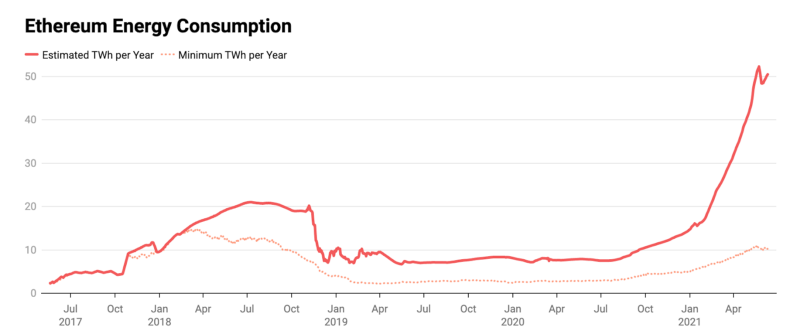Proof of Stake is a Precondition to Blockchain Adoption
Proof of Stake can assuage the sustainability concerns that current Bitcoin and Ethereum mining has sparked.

Table of Contents
It was unfortunately admitted earlier this month that Ethereum 2.0 is taking much longer than was initially expected. Among the many changes that Eth2 will include is the transition from a Proof of Work(PoW) to a Proof of Stake(PoS) consensus mechanism.
The world is increasingly eyeing this transition after the sustainability issues of Bitcoin and Ethereum mining made headlines over the past couple of weeks. Ethereum mining alone consumes 52.2 Terawatt-hours a year and has an annual carbon footprint comparable to the entire country of Jordan.

Digiconomist https://digiconomist.net/ethereum-energy-consumption/
The transition to Proof of Stake, in contrast, is expected to allow the Ethereum network to consume around 99.95% less energy. To understand how we’re going to take a deeper dive into the technology and economics behind consensus models.
Consensus Models and Proof of Work
In order to prevent people from adding fraudulent transactions to the blockchain, every new block has to be validated in a process called mining. The logistics of mining that a cryptocurrency employs are known as its consensus model. In order to incentivize people to validate these new transactions, transaction fees and block rewards are usually given to the miner.
Proof of Work (PoW) is the consensus model used by Bitcoin, and currently used by Ethereum. PoW essentially has miners race against each other to verify the new block in order to claim the reward. The more computational power that one has, the more attempts they can make at validating the block, and therefore the higher chance they have at receiving the reward.
How Proof of Work Created a Mining Hell
In order to keep the verification time near-constant, however, Bitcoin and Ethereum automatically scale the difficulty of mining as more people join the mining race. This means that for all the investment in crypto mining and all the new hardware, the efficiency of mining will always remain constant.
What this has created is an endless arms race in crypto mines that don’t actually make the blockchains themselves any more efficient or secure. The amount of energy necessary to have a chance at earning the block reward has skyrocketed as this mining difficulty has increased. The more worrisome part is that as Crypto adoption increases, the detrimental energy effects of Proof of Work are only going to get worse and worse.
How Proof of Stake Creates Sustainable Cryptocurrency Validation
Instead of having miners race to validate the new block, Proof of Stake assigns the task of validation at random. Each potential validator stakes a certain amount of currency that they are willing to lose if they fraudulently validate the block. Their odds of being assigned the new block are then a function of how much they are willing to stake.
While people will still have to consume energy to validate the new blocks, there won’t be the same arms race for who can attain the most computing power, and will therefore prevent mining from becoming more expensive than it needs to be.
Won’t PoS give an advantage to the rich?
While this is certainly a valid criticism of PoS, it’s important to note that it is still much more equitable than PoW. With PoS, your chance of being chosen as the validator is a linear function of your staked money.
In contrast, since your chances of receiving the reward in PoW are a function of your computing power, there is also an advantage given to wealthier miners. This advantage, however, increases the richer you are because of economies of scale, or the increased efficiency of mining rigs as you spend more on your computing infrastructure.
In other words, in PoS, the person who spends $100 has a 10x advantage over the person who spends $10. With PoW, economies of scale can give the person who spends $100 significantly more than a 10x advantage. While we can hope for a consensus mechanism to arise in the future that is more equitable than PoS, it is still nevertheless a step in the right direction when it comes to equity.
Conclusion
In summation, while it may not be the final solution, Proof of Stake can assuage the sustainability concerns that current Bitcoin and Ethereum mining has sparked. Until we move towards PoS, people that care about climate issues simply cannot adopt Bitcoin or Ethereum with a clear conscience. By eliminating the gargantuan externalities produced by PoW, we can remove one of the most significant hurdles to blockchain adoption.
Thanks for reading! What do you think? Should we avoid cryptocurrencies that are using Proof of Work?
Happy coding from your good friends at Codesphere, the next generation cloud provider

